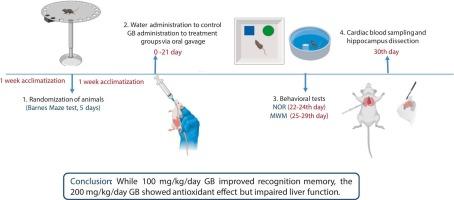银杏叶对健康幼鼠空间记忆和氧化代谢的影响
IF 2.6
4区 医学
Q3 NEUROSCIENCES
引用次数: 0
摘要
银杏(Ginkgo biloba, GB)是一种黄叶草本植物,在中国已有2000多年的历史,用于治疗各种疾病和认知障碍。本研究探讨了两种不同剂量的GB标准化提取物EGb 761对健康幼龄大鼠肝肾功能、海马组织、识别和空间记忆的影响。选用健康雄性8周龄Sprague-Dawley大鼠21只。将大鼠分为3组,对照组(C)给予自来水,实验组(GB100和GB200)给予100和200 mg/kg/d GB。灌胃21 d后,采用新物体识别(NOR)测试评估识别记忆,Morris水迷宫(MWM)测试评估空间记忆。动物在行为测试完成24小时后被安乐死。测定海马组织中肿瘤坏死因子-α (TNF-α)和白细胞介素-1β (IL-1β)水平,测定血清中硫醇、二硫化物、天冬氨酸转氨酶(AST)、丙氨酸转氨酶(ALT)、γ -谷氨酰转移酶(GGT)、尿素和肌酐水平。100 mg/kg GB组NOR试验的识别指数(RI)高于对照组,各组间MWM试验参数差异无统计学意义(P > 0.05)。GB200降低海马组织TNF-α和IL-1β水平,而GB100和GB200均升高血清硫醇水平。GB200降低了二硫化物水平,但提高了肝酶,提示潜在的肝损伤。上述结果表明,200 mg/kg GB具有抗氧化作用,但只有100 mg/kg可改善识别记忆,且对空间记忆均无影响。本文章由计算机程序翻译,如有差异,请以英文原文为准。

Effects of Ginkgo biloba on spatial memory and oxidative metabolism in healthy young rats
Ginkgo biloba (GB) is a yellow-leaved herb used in treating various diseases and cognitive disorders in China since 2000 years. This study investigates the effects of two different doses of GB, in the form of its standardized extract EGb 761, on liver and kidney functions, hippocampal tissue, and recognition and spatial memory in healthy young rats. Twentyone healthy male Sprague-Dawley rats, aged 8 weeks, were utilized. Rats were equally divided into three groups as control group (C) given tap water, experimental groups (GB100 and GB200) given 100 and 200 mg/kg/day GB. Following a 21 days of oral gavage, recognition memory was evaluated using the novel object recognition (NOR) test, while spatial memory were assessed using the Morris water maze (MWM) test. Animals were euthanized 24 h after the completion of the behavioral tests. Tumor necrosis factor-alpha (TNF-α) and interleukin-1β (IL-1β) levels were assessed in hippocampal tissue, while thiol, disulfide, aspartate aminotransferase (AST), alanine aminotransferase (ALT), gamma-glutamyl transferase (GGT), urea, and creatinine levels were measured in serum samples. The recognition index (RI) in the NOR test was higher in 100 mg/kg GB group compared to control, whith no differences in the MWM test parameters among the groups (P > 0.05). GB200 reduced hippocampal TNF-α and IL-1β levels, while both GB100 and GB200 increased serum thiol levels. GB200 decreased disulfide levels but raised liver enzymes, suggesting potential liver impairment. These findings suggest that while 200 mg/kg GB exerts antioxidant effects, only 100 mg/kg improves recognition memory, and neither dose affects spatial memory.
求助全文
通过发布文献求助,成功后即可免费获取论文全文。
去求助
来源期刊

Brain Research
医学-神经科学
CiteScore
5.90
自引率
3.40%
发文量
268
审稿时长
47 days
期刊介绍:
An international multidisciplinary journal devoted to fundamental research in the brain sciences.
Brain Research publishes papers reporting interdisciplinary investigations of nervous system structure and function that are of general interest to the international community of neuroscientists. As is evident from the journals name, its scope is broad, ranging from cellular and molecular studies through systems neuroscience, cognition and disease. Invited reviews are also published; suggestions for and inquiries about potential reviews are welcomed.
With the appearance of the final issue of the 2011 subscription, Vol. 67/1-2 (24 June 2011), Brain Research Reviews has ceased publication as a distinct journal separate from Brain Research. Review articles accepted for Brain Research are now published in that journal.
 求助内容:
求助内容: 应助结果提醒方式:
应助结果提醒方式:


